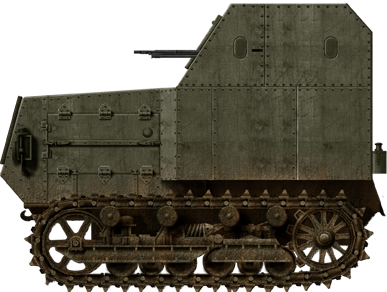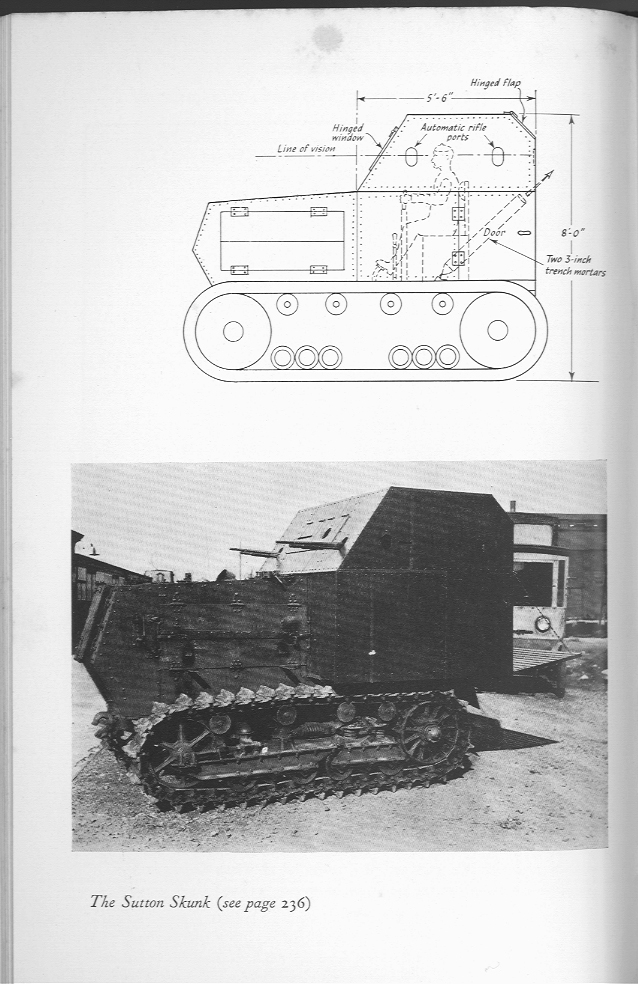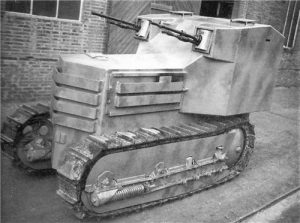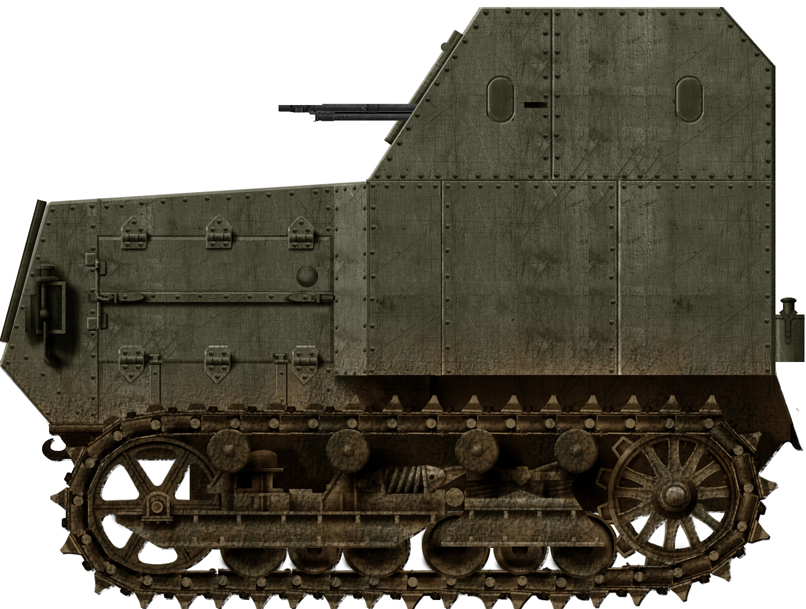 United States of America (1932)
United States of America (1932)
Tractor Tank – 1 Prototype Built
One-Armed Sutton’s masterpiece
The Sutton Skunk was a little-known tractor tank from early 1932, built for the Chinese export market by Frank ‘One-Arm’ Sutton – Englishman and adventurer. In his time, Sutton made many inventions, and this was perhaps one of his most ambitious. It was simply a Caterpillar 5-ton M1917 tractor that was borrowed from the military and armored up. Featuring two 82mm Stokes mortars and a pair of Browning machine guns, it was a fairly well-armed tankette, almost certainly designed with infantry support in mind.
Who was One-Armed Sutton?
Francis Arthur Sutton (1884-1944) was an English soldier and adventurer who spent no less than 29 years of his life traveling across the globe, having come up with various money-making schemes. His story begins in WWI, at Gallipoli whilst serving with the Royal Engineers. There, he lost part of his hand by throwing no less than six enemy grenades back into the trenches they were thrown from, with a seventh exploding in his hand, for which he earned the Military Cross, and the name “One-Armed Sutton“.
From 1915 onward, he began inventing various weapons such as heavy trench mortars and new fuse systems, which saw him travel to America in 1917 on business, after being released from duties with the British army. After earning a huge fortune for his designs, he invested his money in a gold-dredging business in Siberia. He traveled out there himself, but was forced to leave after the Red Army took control of Blagoveshchensk by 1921. After his dredging machinery was confiscated, he entered negotiations with a Red Army Commissar, who generously paid him off, and Sutton promptly left for Manchuria to cash the cheque the Commissar had written.
Finding the cheque to be good, he spent the next few years hopping back and forth between the two countries, but eventually had to stay in Manchuria, when he had spent all of his small fortune. In Manchuria, he became an advisor to Chinese Warlord Zhang Zuolin (Chang Tso-Lin), and was made a General of the Chinese Army. In 1927, however, he went to Canada, and invested his new fortune in real estate. However, as a result of the Great Depression, he lost that fortune in 1929.
He sold all of his possessions, bar two sets of clothes, paid off all of his debts, and with a few thousand dollars in hand, he began traveling across the USA to search for sponsorship for arms deals to China. His initial proposal to sell aircraft was rejected by most companies, but once he went to Peoria, Illinois, where the M1917 5-ton semi-armored tractor was built, he came up with an ingenious idea.
Sutton took a train to Philadelphia, and, somehow, convinced the Colonel Commandant of the Frankford Arsenal to lend him a tractor for “the purpose of taking some measurements”. He drove the tractor over to Henry Disston’s Steel Works and set to work…
Design
The Sutton Skunk was essentially an armored body placed on the Caterpillar semi-armored 5-ton M1917 artillery tractor. In 1918, the American Army had huge numbers of the tractor, and by 1932, still had 600 in surplus. Trying to get rid of them, the vehicles were actually up for sale, and the US army eventually lowered the price from $8000 ($140,000 in today’s money) to $800 ($14,000 in today’s money). This is likely one of the reasons that the Colonel simply lent federal property to the silver-tongued Sutton.
At Disston’s steel works, the back seats, fuel tanks, and other ‘unimportant’ components were stripped out, and Sutton said: “I’d like to see the Frankford Colonel’s face if he happened to walk in here now!”
The engine and driver’s seat were enclosed in bullet-proof steel and he built a large superstructure on the rear, which made the vehicle eight feet tall. Two Browning machine guns were mounted on either side of the driver, forwards facing, in crude gun ports. There were also two pistol ports on both sides of the hull for automatic weapons and smoke grenades.
In the rear, two 82mm Stokes mortars were also fitted, which Sutton helped design a new and improved fuze for back in 1917 (which made him his first fortune). This was in fact the source of the name, as Sutton is reported as saying “I’m calling it the Sutton Skunk, as both big guns shoot out of the rear“. According to a technical drawing as included in “General of Fortune“, it seems as though the vehicle would only have one crew member, but it is probable that possibly one or two others would operate the guns.
Fate of the Sutton Skunk
Sutton had the intention of selling the vehicle to the Chinese, whom he had spent many years with, as mentioned, in service with one of the strongest warlords in China (in fact, Sutton deemed Zuolin the greatest of them all). For the far east, it could easily be deemed an excellent vehicle with serious export prospects, because whilst quite unimpressive to western militaries, it would impress the Chinese, who had little or no experience of armored warfare. The armaments might sound unimpressive in retrospect, but would be little need for a vehicle to combat other tanks. Apart from which, the Sutton Skunk would be fairly cheap.
However, this is where all clear-cut and clarified information on the Sutton Skunk ends.
Sutton stated that he was going to ship this prototype to China and sell them like hot cakes, and in August, 1932, he indeed sailed for Shanghai, but the only source for this journey is the book “General of Fortune“, which does not clearly state any substantial information about the negotiations behind the sale of the Sutton Skunk.
At this time China was preparing for war against Japan, that had already seized Manchuria practically unopposed, and the preparations for war were in the hands of a German Military Mission headed by General von Seekt. According to “General of Fortune” – “there was no need for talented amateurs like Sutton, nor his ingenious improvised tractor tank“. This seems to imply that he attempted the sale of the vehicle, but had to deal with the German military in doing so, and was ultimately unsuccessful.
In terms of selling arms to warlords, even though they still operated independently and therefore he could negotiate with each on a separate basis, he felt as though he had already fought with the best – Zhang Zuolin (Chang Tso-Lin), who died four years earlier in 1928. He simply refused to side with, and therefore sell arms to, any other warlord. There were also Communist rebels, but having had his fill of Communism in Siberia, Sutton refused to sell arms to them, too.
Possible arrival in China?
The fate of the prototype Sutton Skunk remains unknown, and it is unclear whether or not it was actually brought to China or not, as it is not mentioned again in the book ever again. It might even be possible that the vehicle was assembled, photographed, and returned to the Frankford Arsenal in one day.
According to “Armour in China, Military Modelling Annual (1983)“ by Steven Zaloga, the Chinese were building improvised armored cars since 1930, and improvised tanks in 1932. There is clear photographic evidence for the existence of improvised armored cars in China, but none for the existence of improvised tanks. The Studebaker tank is a well-known mystery, and it was most probably smuggled in by foreign arms dealers.
In April, 1932 Marshal Liu Hsiang formed a unit for armored cars and tanks in Chongqing.
Liu Hsiang’s story is seemingly hard to trace, but according to “China’s Wings” by Gregory Crouch, in 1931, he controlled Sichuan Province (which is just next to Chongqing – therefore, the story makes sense at least geographically), a huge army, and plenty of airplanes smuggled from Indochina by French arms dealers.
It is suggested that six improvised tanks were built based on tractors – five on a Cletrac 20 featuring a Lewis Gun, and one on a larger Cletrac 30 featuring a Lewis Gun and a 37mm gun. However, there are no photographs of either vehicle.
The connection to the Sutton Skunk would be that the Chinese designs were inspired by the Sutton Skunk, thus proving that the Sutton Skunk did, in fact, make it to China. Unfortunately, Sutton set sail for China in August of 1932. Assuming that the date of April 1932 for the formation of the tank unit is correct (and, indeed, that it truly happened), then these Chinese tractor tanks seem to have developed independent of the Sutton Skunk earlier in the year. This also assumes that Sutton did not market the idea earlier in the year before setting sail to China, or that he did not send the Sutton Skunk to China before his departure in August.
Sutton’s final years
Sutton later moved to Korea with another mining operation, but he was expelled by the Japanese in 1941. He later died in a POW camp in Hong Kong in 1944; the amazing man lost to history. Sutton’s story was written about by use of diaries, journals, and letters in the 1963 biographical book by Charles Drage – “General of Fortune, the fabulous story of One-Arm Sutton“, but Sutton still remains an obscure footnote in history, this article only scratching at the surface of his story.

Rendition of the Sutton Skunk.

The schematic and only known photo of the Sutton Skunk, as taken from “General of Fortune, The fabulous story of One-Arm Sutton“, by Charles Drage.
Sidenote I: Stolen idea?
The Disston Tractor Tank was a slightly later and similar design that was most likely made after the Sutton Skunk (although information on both vehicles is very limited). The date of creation of the Disston is a very important fact, as it may be possible that the Disston company stole the concept and design elements from Sutton.
The Disston is almost as obscure as the Sutton Skunk, and its exact year of production is also hard to pinpoint. According to sources, the earliest possible year that the Disston was seen was in 1933, when the prototype was likely built, as the earliest known hard evidence suggests that the Disston was marketed in January 1934, with a photograph of the prototype included.
Either way, all evidence places the Disston being made after the Sutton Skunk. Whilst bearing the name “Disston” (likely as a marketing technique to use the trusted brand name), it was the idea of the Caterpillar Company, and therefore, the concept of this tractor tank appears to have developed independently of the Sutton Skunk. However, the Caterpillar Company was based Peoria, Illinois, where the Sutton Skunk was made, and it may have perhaps been seen by them. Also, the specifics of the deal between Disston and Caterpillar are unclear – it is known that Caterpillar supplied the tractors, which were, almost certainly armored up at the Disston works. That being the case, it remains unclear which company made the exact design, and it is possible that if Disston made the exact design, then elements of the Sutton Skunk were borrowed.
The book, “General of Fortune, the fabulous story of One-Arm Sutton“, the only source for the Sutton Skunk, reveals few details on the tank’s construction. It will remain unknown if the Disston Tractor Tank was inspired by the Sutton Skunk or not.
Sidenote II: Mercier Tank
The Mercier tank or “Aragón Tank” was a tank based on a Caterpillar 22 tractor from 1937 (during the Spanish Civil War). A single prototype was made at the Mercier works in Zaragoza, Nationalist-occupied Spain. It featured a pair of Hotchkiss machine guns mounted in a superstructure very similar to the Sutton Skunk, except for the machine guns being mounted in specially built mounts, as opposed to simplistic holes cut in the armor. The project was never developed past a single prototype, but it, strangely, looks very similar to the Sutton Skunk. There is no likely connection between the two.

The Mercier Tank or “Aragón Tank”, circa 1937. It looks very similar to the Sutton Skunk, but there is no likely connection between the two.
Sources:
“General of Fortune, The fabulous story of One-Arm Sutton“, by Charles Drage, 1st edition, 1963
“Arming the Chinese, the Western Armaments Trade in Warlord China, 1920-1928“, by Anthony B. Chan, 2nd edition, 2010
“China’s Wings” by Gregory Crouch
“Armour in China, Military Modelling Annual (1983)“ by Steven Zaloga
shushpanzer-ru.livejournal
ftr.wot-news.com
Letter correspondence from Otto Kafka to the Kuwaiti Minister of War


2 replies on “Sutton Skunk”
It seems silly that the mortars were rearward firing – the Skunk would have to turn around so that they could fire directly at the enemy.
not really? This is an indirect fire artillery vehicle and having the ability to just drive off when enemies approach instead of having to back out and turn both of which are usually slower than forward motion, is more useful than facing the enemy. if this was something that is meant to engage in direct fire ranges like the Archer Tank Destroyer i would be inclined to agree with you.